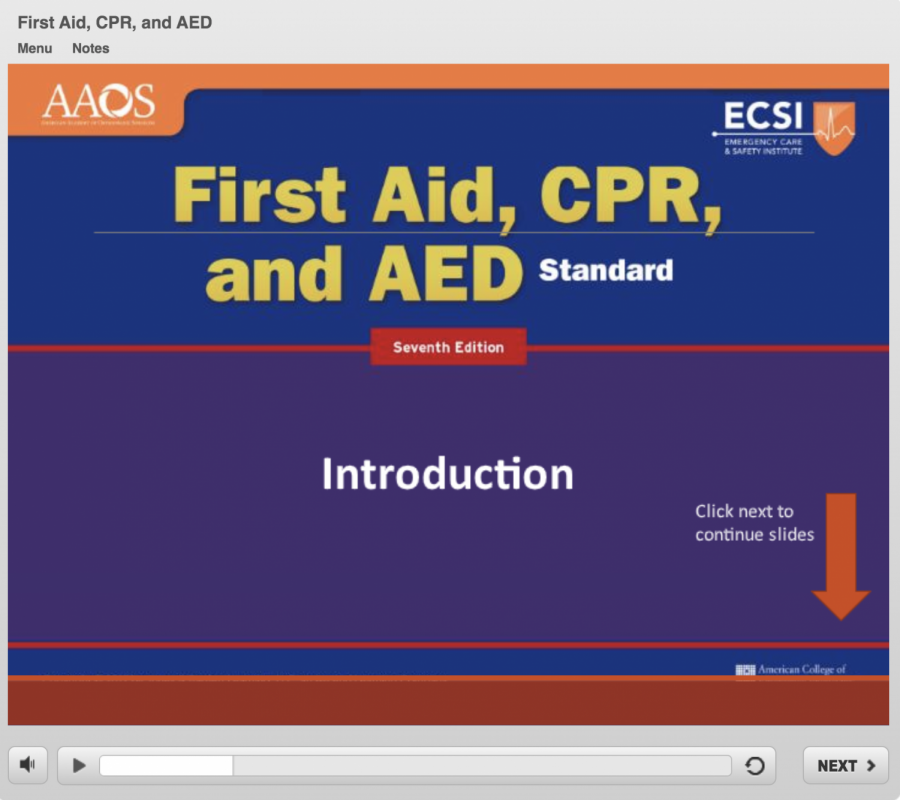First aid, second priority
The online course from the Emergency Care and Safety Institute (ECSI) for learning CPR, AED, and first aid as required by the state. There are 7 modules which freshmen must complete as well as a ten question test as opposed to the hands-on experience students would get in a regular school year. “Under normal circumstances, the way I teach this at school is to cover a module, and then go into the hands on or lab portion of the course. This is where students will practice the proper way to apply a sling, provide direct pressure for bleeding wounds, or learn how to put a splint on a broken arm, or leg, along with additional topics,” health and P.E. teacher Mr. Barry Potoker said.
June 10, 2020
Freshman students at Jefferson are learning first aid and CPR through an online course this spring. Since the COVID-19 pandemic forced us into distance learning, teachers and students have had to adjust methods. The first-aid, CPR, and AED curriculum is standard across Virginia to ensure students are taught up to date, proper methods. However, now the absence of hands on experience threatens the quality of training.
Health/PE students in 9th grade are expected to complete an online course in the form of multiple modules in the place of usual CPR and first aid training. Health/PE teacher Barry Potoker explained it this way, “we have assigned the Modules as homework with questions that need to be answered. During our synchronous class time, we cover the module and answer any questions that students have, as well as going into more depth.”
The online course is mandated across Virginia. Our teachers and FCPS county are doing their best considering the unexpected circumstances. In fact, the teachers are allowing more time for students to spend on the course than would usually be spent during the school year. However, the amount of class time spent on the first aid training this year is lower. “I normally take about three weeks or 9 class periods to complete the entire program,” Potoker said. It would take eighteen distance learning class periods to equate those 9 class periods.
Even if teachers spent eighteen class periods on first aid training plus the online course modules, students lack hands-on experience. “There is no substitute for the actual ” hands on” portion of the class. Anyone can read a book about how to apply a splint or do CPR on an infant. But until you actually practice the skill over and over and make it muscle memory it can be difficult to grasp,” Mr. Potoker explained.
Students cannot be expected to pick up life skills such as recognizing the difference between a heart attack and a stroke through slideshows and videos. In fact, the course features minimal imagery at all. Although there are some videos, detailing how to wrap an arm in gauze or put a person in a recovery position, most of each module is made up of slides of text. CPR, AED, and First Aid training are required for a high school student to graduate in Virginia.
FCPS specifies that “hands-on practice of the skills necessary to perform cardiopulmonary resuscitation” is required or a standard high school diploma. Apparently, that notion has been thrown out the window in current circumstances.
Even students who choose to take online Health/PE 9 do not get to skip out on hands-on practice. They take a similar course, but it is supplemented with a required session of hands-on practice at some point during the summer. At the real-life session, participants must demonstrate chest compressions and how to use an automated external defibrillator (AED), among other things.
Jefferson teachers hope to pick up next year and cement their teachings, but no one can predict how long the pandemic will last. The plan for reopening school next year is still unclear.
Instead, the VDOE could revise their online course. The VDOE and FCPS should be asking themselves how to implement hands-on activities through distance learning. The Red Cross, for instance, offers online first aid classes which are highly interactive and similar to a simulation.
“I tell every class these are valuable lifesaving skills – you never know if, and when you will be called to apply these skills in a real world setting,” Potoker said. It is better to be safe than sorry. It is better for students to be trained in case of an emergency rather than be caught unprepared.
Reading slideshows cannot replace hands-on experience, but hands-on experience is unattainable at the moment. Officials who manage our education should be doing more to make sure students are properly trained – maybe now more than ever.






